In this post, we will show you how to fix the error message Could not configure the disk space used for System Protection on a Windows 11/10 PC. The message is linked to error code 0x80042306 which occurs when users try to create a restore point on their system.
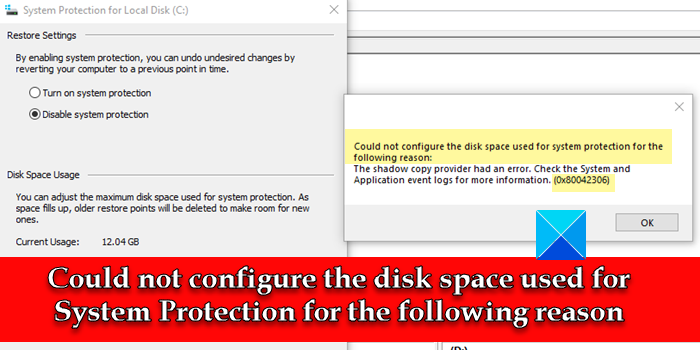
The above error prevents users from creating the restore point, typically when there’s insufficient free space on the disk drive for the shadow copies or an internal issue with the Volume Shadow Copy Service. A few users have also encountered the error when they tried to disable System Protection after upgrading Windows to a new build. The complete error message reads:
Could not configure the disk space used for System Protection for the following reason:
The shadow copy provider had an error. Check the System and Application event logs for more information. (0x80042306)
If you’re struggling with the same error message, read this post to learn how to fix the issue.
Could not configure the disk space used for System Protection (0x80042306)
We suggest using the following solutions to fix the error message Could not configure the disk space used for System Protection on Windows computers:
- Free up space on the target disk
- Check for software conflicts
- Perform CHKDSK scan
- Run the System File Checker
- Configure necessary services
- Re-Register VSS Components
- Format the target drive as NTFS
Let us see these in detail.
1] Free up space on the target disk
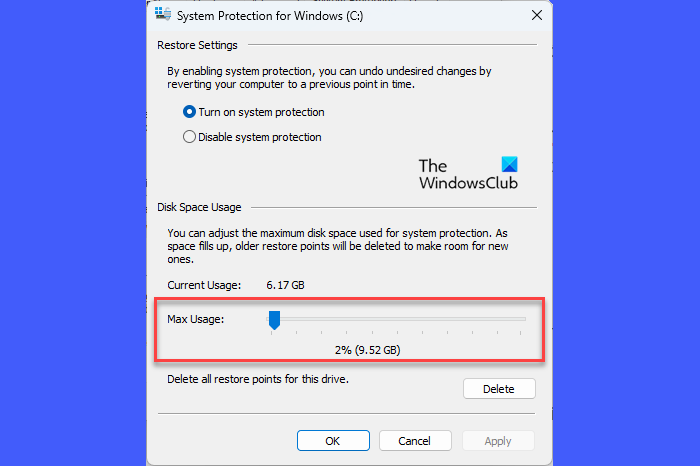
The disk you’re using to create the restore point might not have adequate free space, which depends on the size and complexity of your operating system. You can manually increase the disk space by uninstalling the apps you no longer need or by moving them to another drive. You can also use Windows’ built-in Disk Cleanup utility to free up disk space.
Alternatively, you can increase the amount of disk space allocated for System Restore on the disk where System Protection is enabled. Here’s how to do it on a Windows 11/10 PC:
Press Win+R to open the Run dialogue box. Type systempropertiesprotection and press the Enter key. The System Properties dialogue box will appear. Switch to the System Protection tab.
Under Protection Settings, select the drive on which you’re trying to create the restore point. Click on the Configure button.
In the next pop-up window, use the Max Usage slider to increase the space allocated on the selected drive for System Protection.
Click on Apply > OK to save changes. Now check if this fixes the error.
2] Check for software conflicts
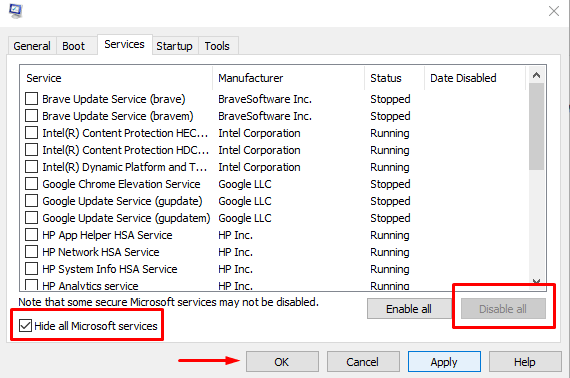
When multiple backup solutions are simultaneously installed on a system, software conflicts may arise, as these backup solutions have their own individual snapshot managers. You can perform a clean boot to identify any software conflicts that may be generating error 0x80042306.
3] Perform CHKDSK scan
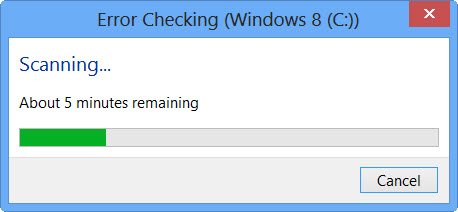
Since error 0x80042306 is primarily a disk error, it is recommended to run the CHKDSK utility. CHKDSK examines the integrity of disk partitions by looking for corrupted entries in a volume’s Master File Table or for logical file system errors. If any corrupt files are found, CHKDSK attempts to separate them and save the remnants in .chk file format.
To run CHKDSK on your System Drive (C:), execute the following command in an elevated Command Prompt:
chkdsk /r C:
The above command will scan the drive for errors and bad sectors. To fix errors scanned by CHKDSK, execute the following command:
chkdsk /f C:
Replace the drive letter if the target is a different drive. Wait until the scan is complete. Then reboot your PC.
4] Run the System File Checker
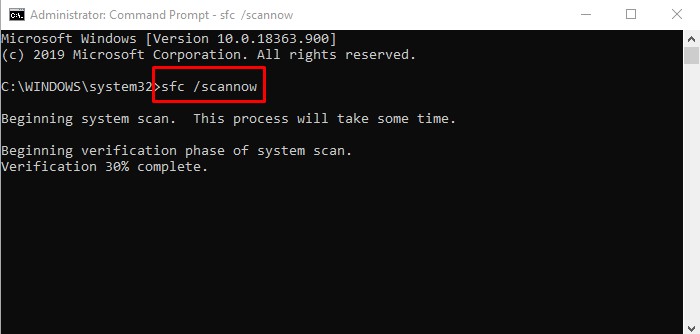
Next, run the System File Checker tool to identify and repair any corrupt system files. If any corruptions are found, SFC will replace those files with their cached copies which are saved locally in Windows.
5] Configure necessary services
A] Volume Shadow Copy Service (VSS)
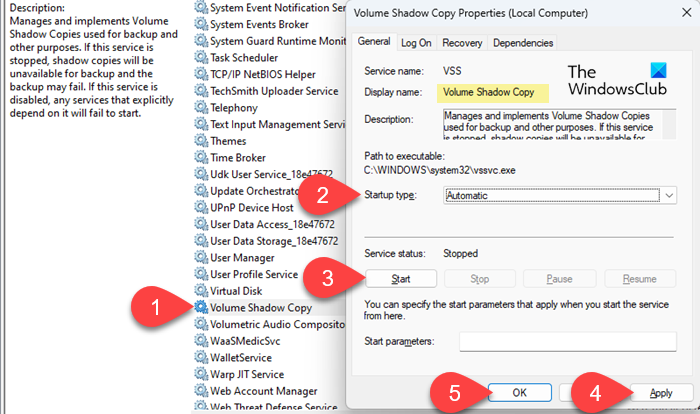
System Restore primarily works with the Volume Shadow Copy Service (VSS). If this service has stopped running, you may encounter error 0x80042306. You can check the status of the service using the Windows Services Manager (Services.msc).
Type ‘services’ in the Windows Search bar and click on Run as administrator under the Services app. Withing the Services Manager window, navigate to the Volume Shadow Copy service. Right-click on it and select ‘Restart‘.
If the option is disabled, double-click to open the service properties window. Set the Startup type to Automatic and click on the Start button. Then click on Apply > OK to save changes and exit the service properties window.
B] Windows Backup Service
Windows Backup Service performs backup operations on a system. If restarting the Volume Shadow Copy Service won’t help fix error code 0x80042306, repeat the above steps for Windows Backup Service as well.
Read: Shadow copies failed to change the storage area maximum size
6] Re-Register VSS Components
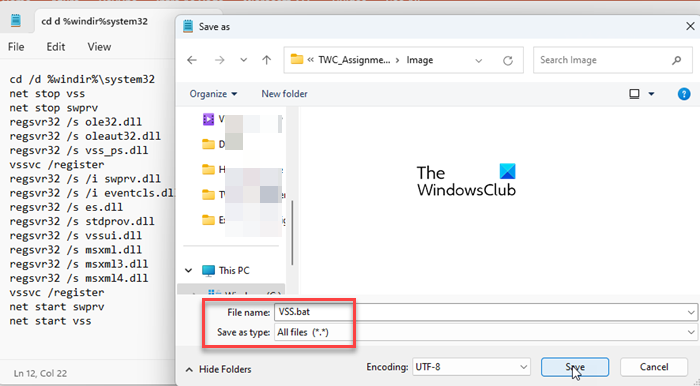
If the error persists after restarting the Volume Shadow Copy service, you’ll have to re-register the VSS components. This includes executing multiple commands in the Command Prompt. Here’s how to do that using a batch file in Windows:
Open Notepad and paste the following command into a new file:
cd /d %windir%\system32 net stop vss net stop swprv regsvr32 /s ole32.dll regsvr32 /s oleaut32.dll regsvr32 /s vss_ps.dll vssvc /register regsvr32 /s /i swprv.dll regsvr32 /s /i eventcls.dll regsvr32 /s es.dll regsvr32 /s stdprov.dll regsvr32 /s vssui.dll regsvr32 /s msxml.dll regsvr32 /s msxml3.dll regsvr32 /s msxml4.dll vssvc /register net start swprv net start vss
Save the file as VSS.bat. Click on File > Save as. In the Save as dialogue box, select All Files in Save as type. Type VSS.bat in the File name field and click on the Save button to save the file in a desired location on your PC.
To run the commands, right-click on the batch file and select Run as administrator. Then click on Yes in the User Account Control prompt that appears. Command Prompt will be launched and execute all commands one after the other.
Similar: The restore point could not be created due to the following reason, The shadow copy provider had an error (0x80042306)
7] Format the target drive as NTFS
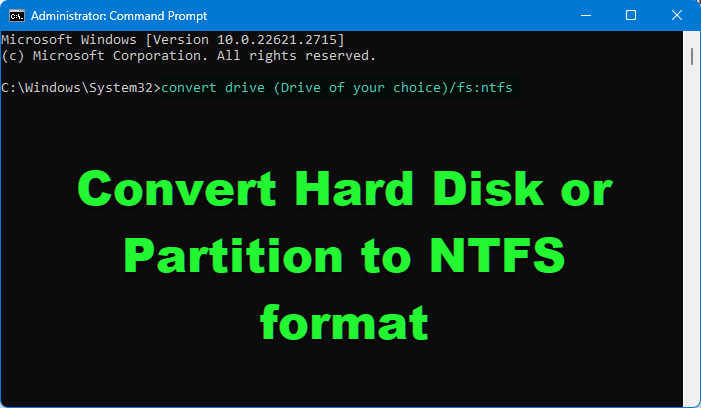
System Protection requires the Windows NTFS or ReFS filesystems to create and store shadow copies. If your target drive is not formatted to NTFS, conflicts may appear during the snapshot process. To fix this, you may convert the drive or partition to NTFS.
I hope this helps.
Also Read: Hard Drive keeps filling up by itself automatically for no reason.
How much disk space should I use for system protection?
A restore point roughly requires around 1 GB of storage space. You should use around 5-10% of your total hard disk space for system protection. As this space fills up, the system deletes older restore points to make space for new ones. However, you can change the maximum storage space per drive (for system protection) via System Properties.
How do I configure and enable system protection?
To enable system protection, go to Settings > System > About. Click on the System protection link under Device specifications. In the System Properties window, select the target drive and click on Configure. Then select the Turn on system protection option to enable system protection on the selected drive.
Read Next: System Restore not working, failed, or did not complete successfully.
Leave a Reply